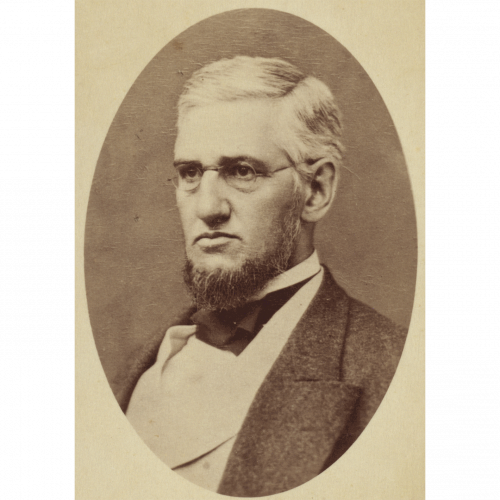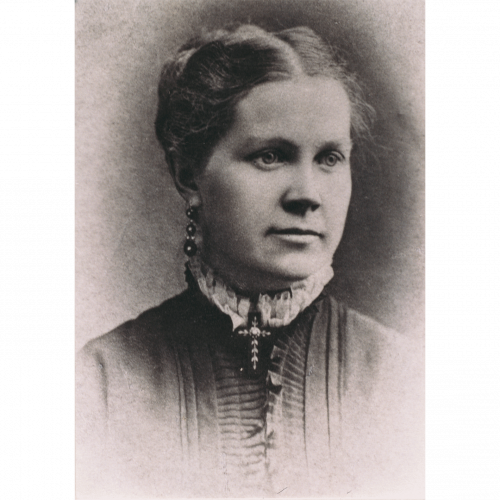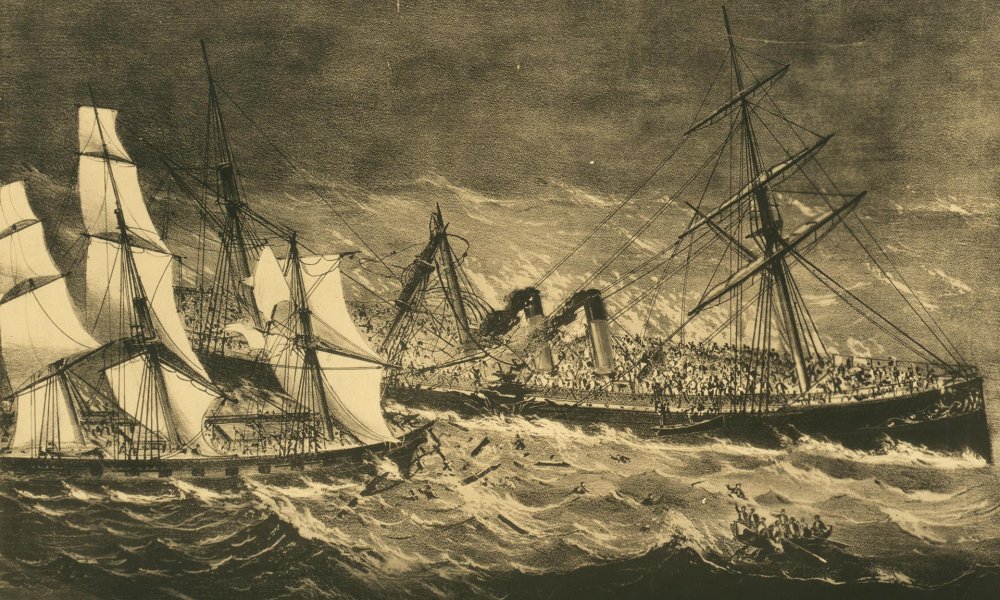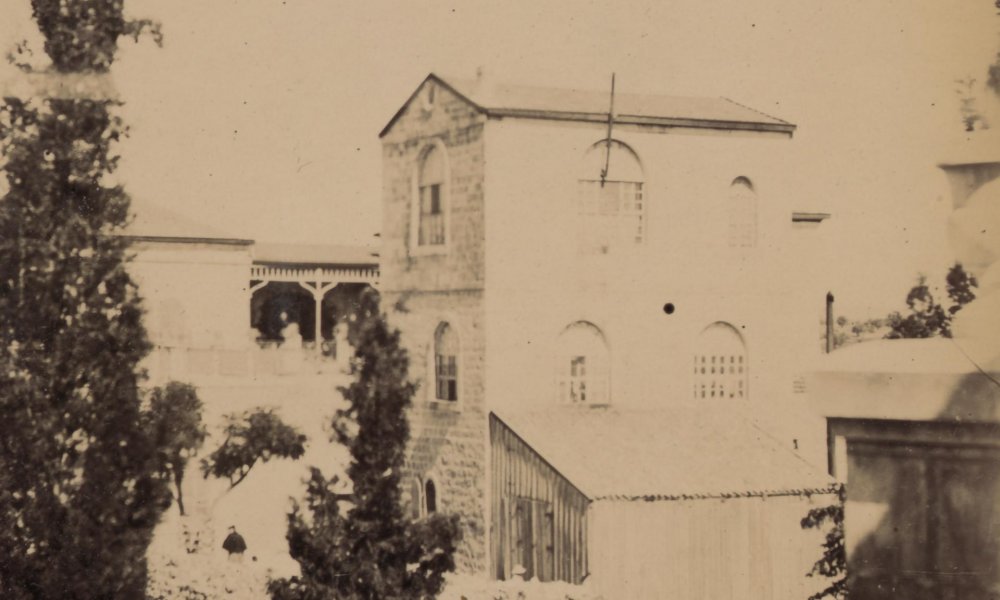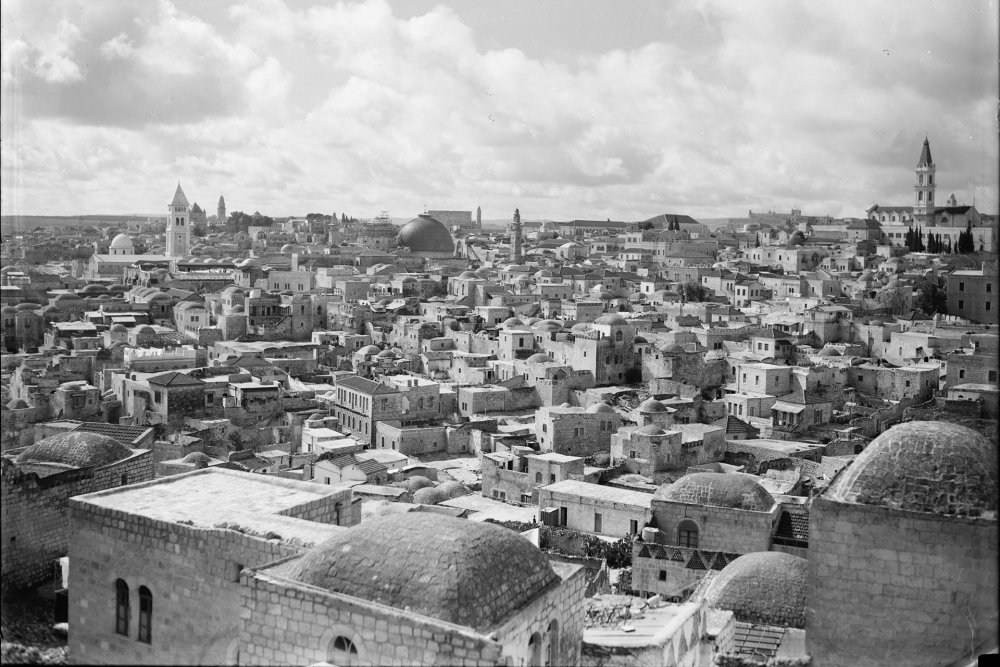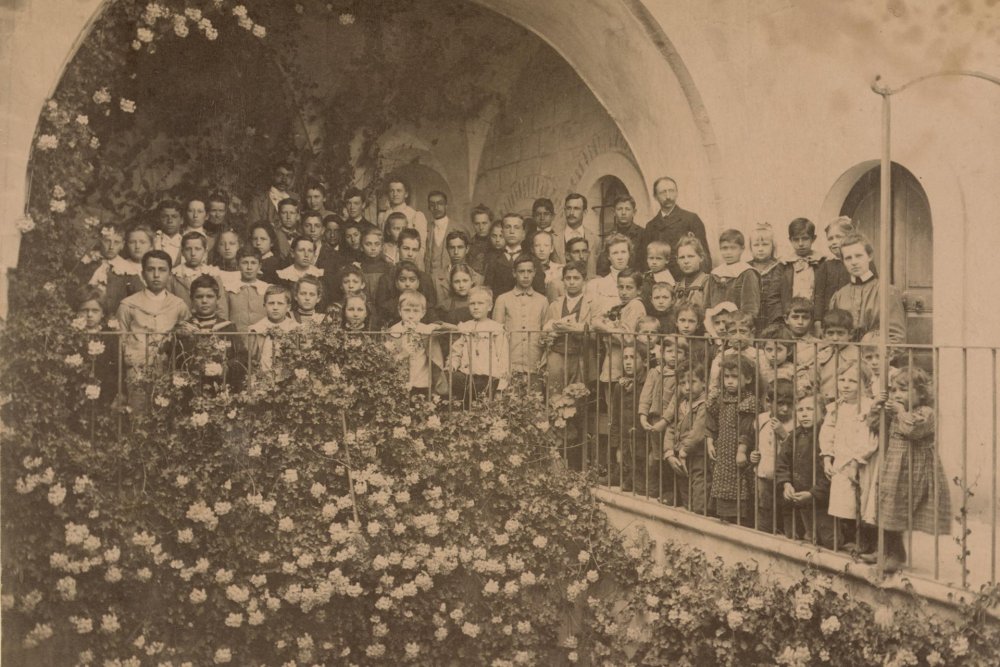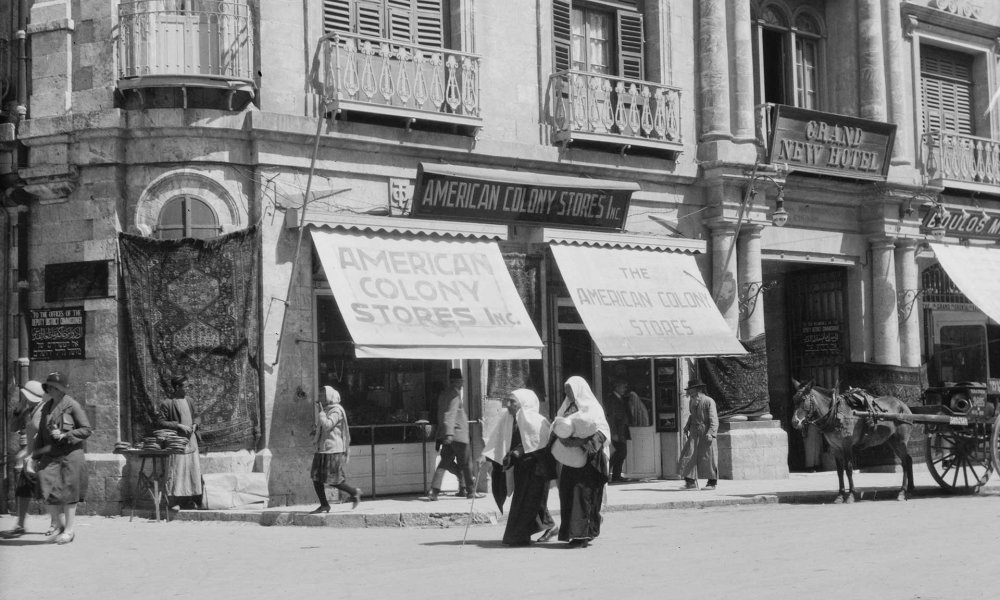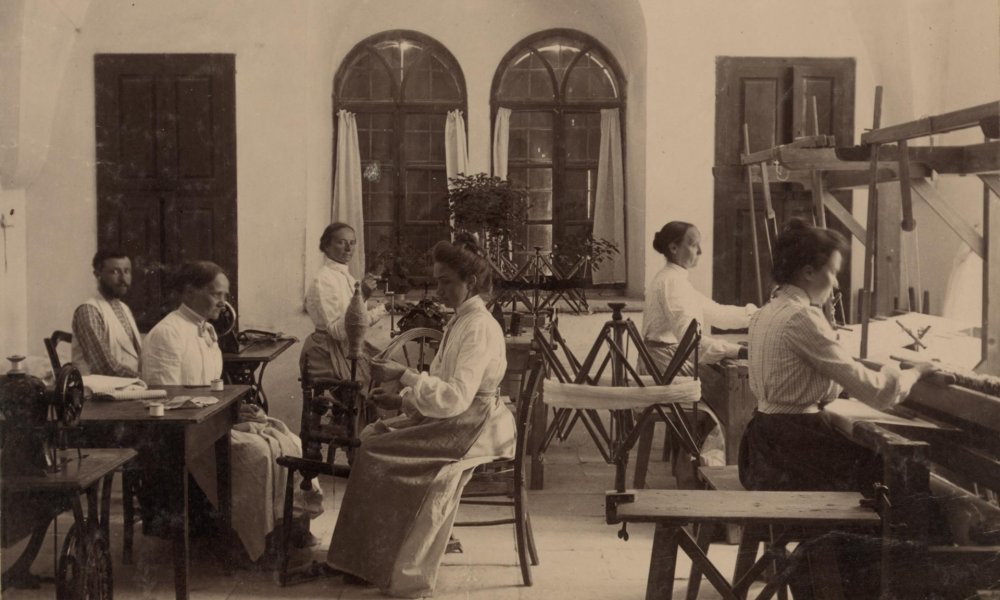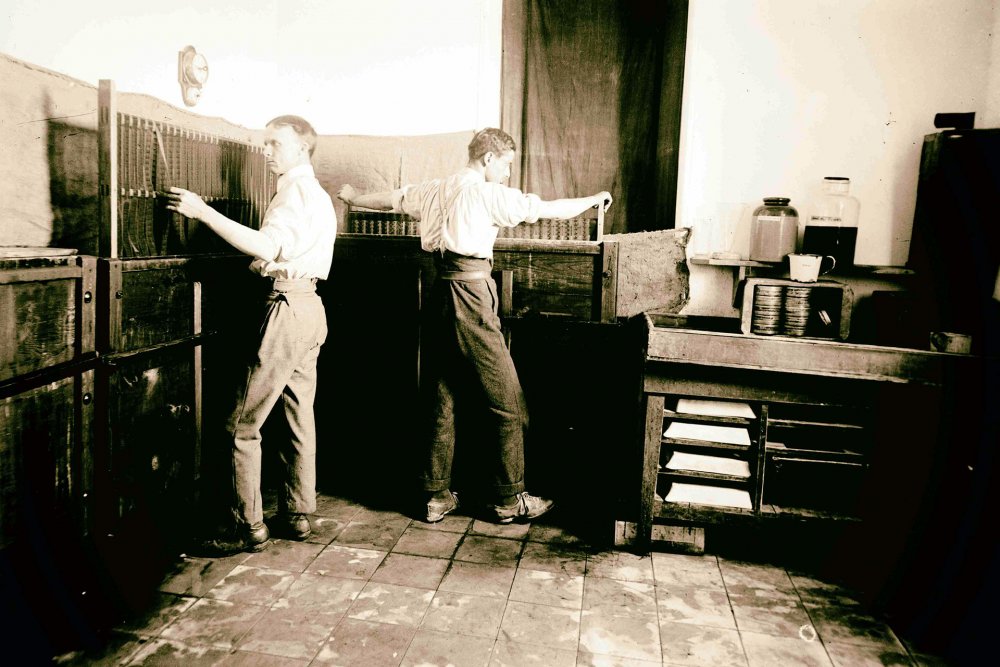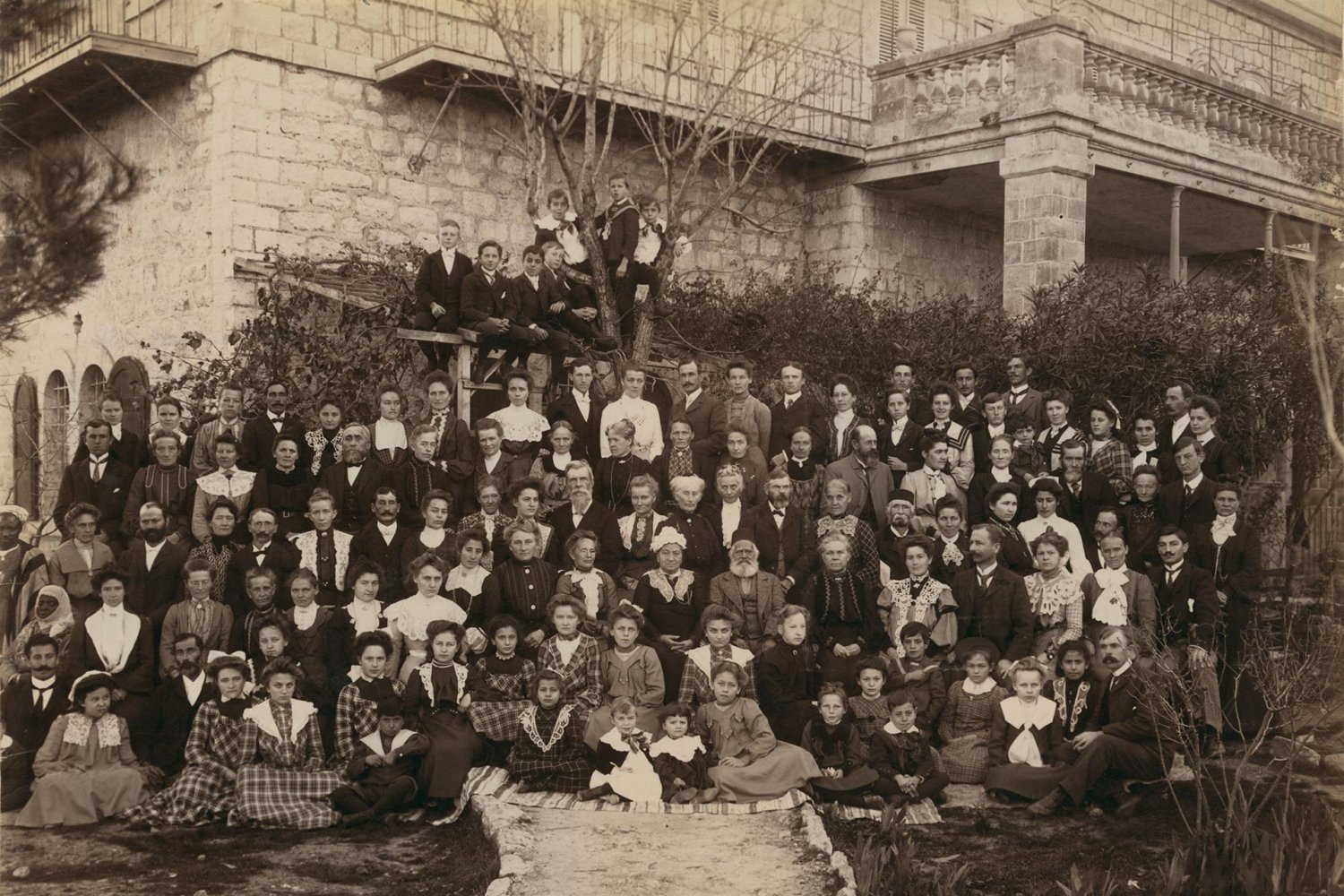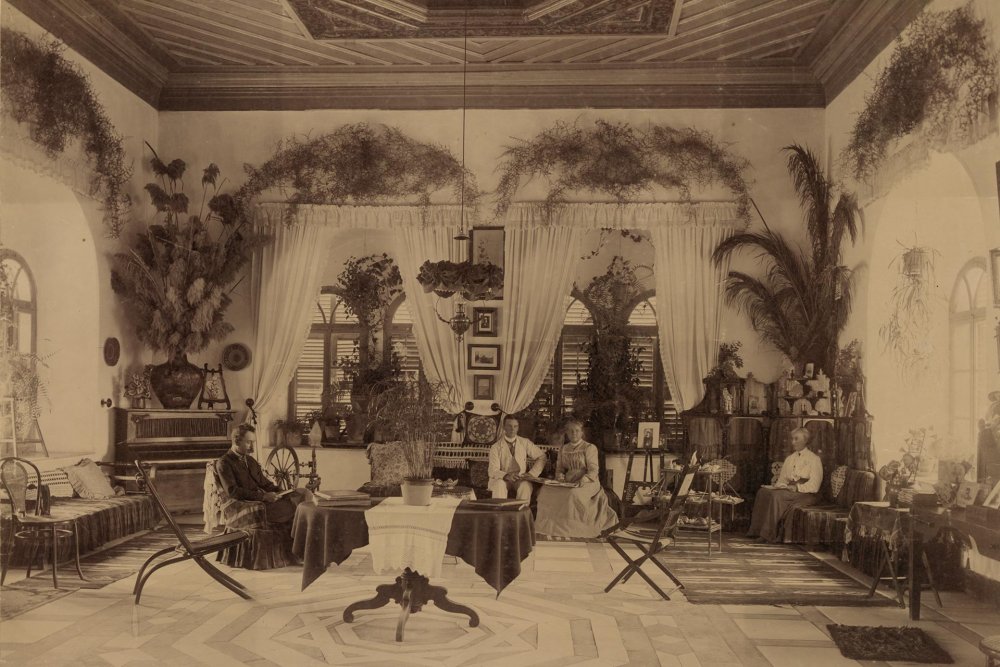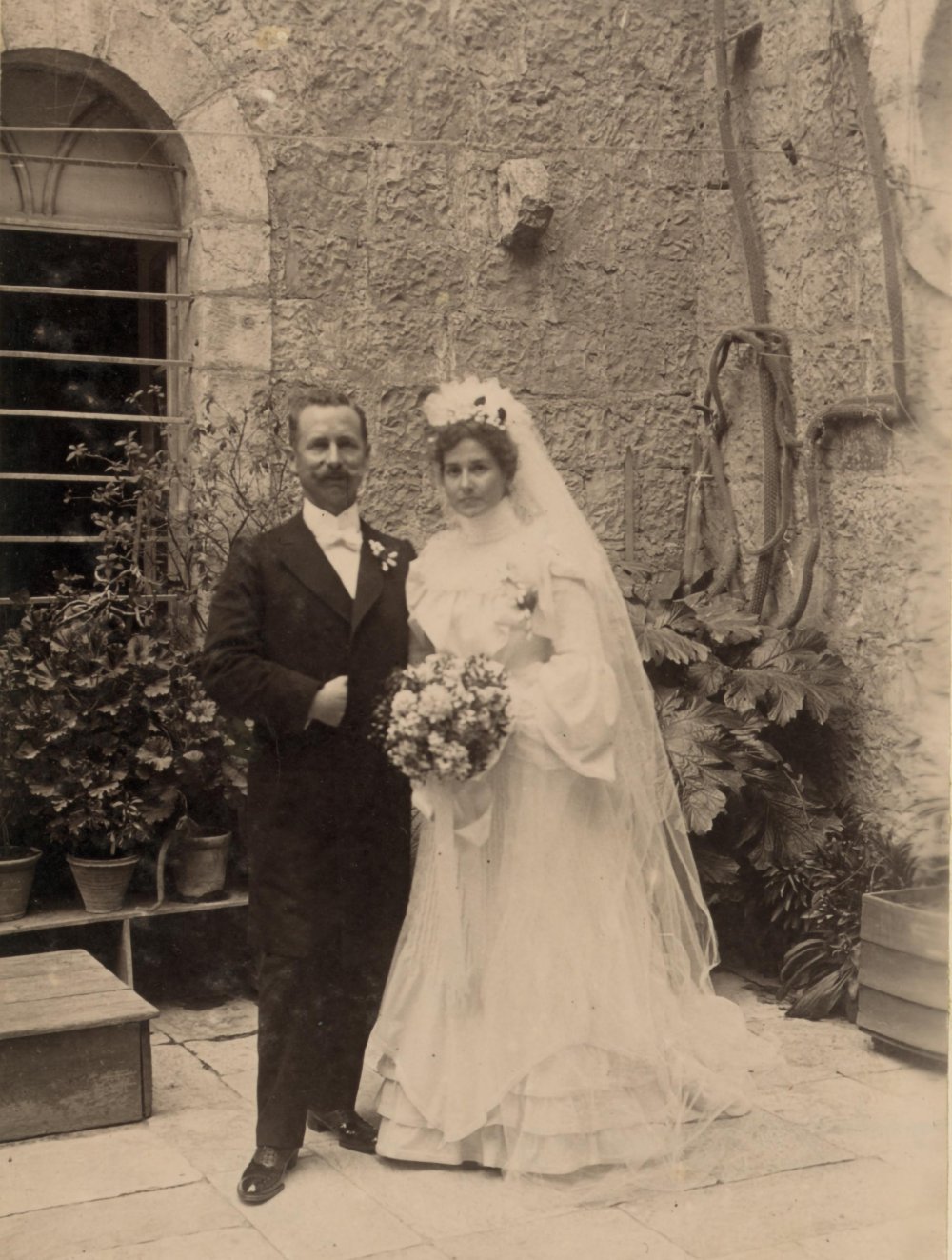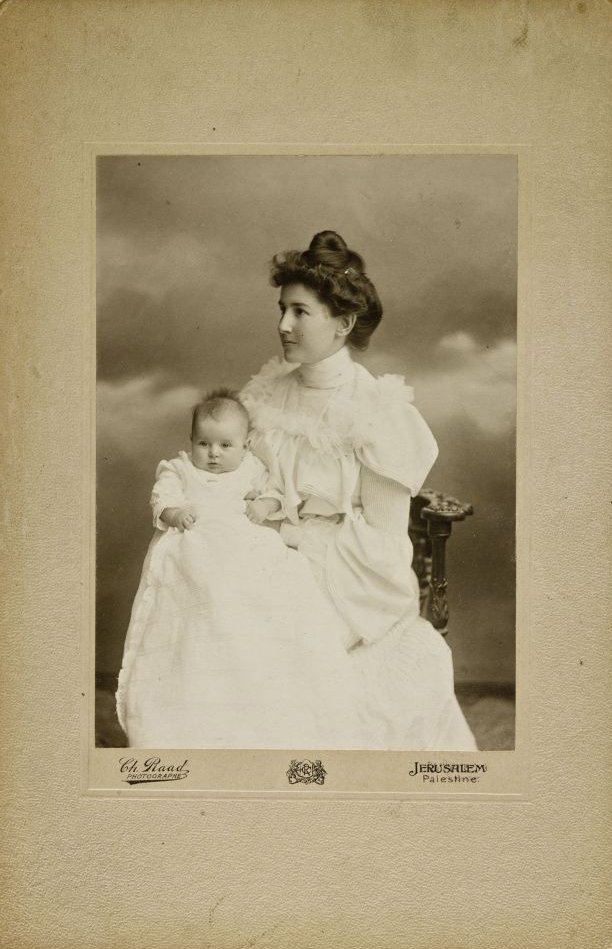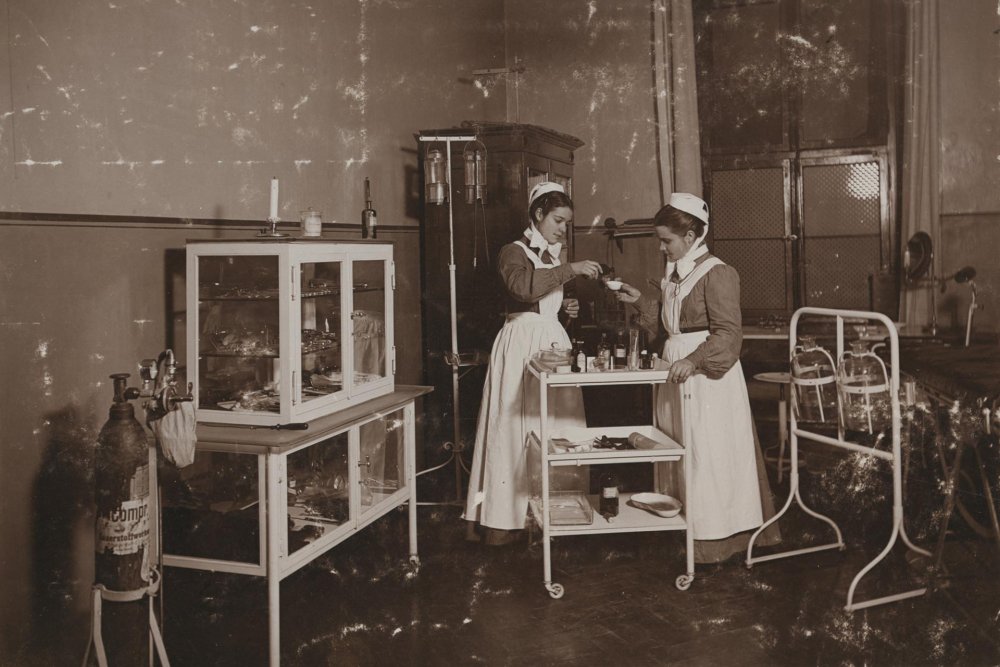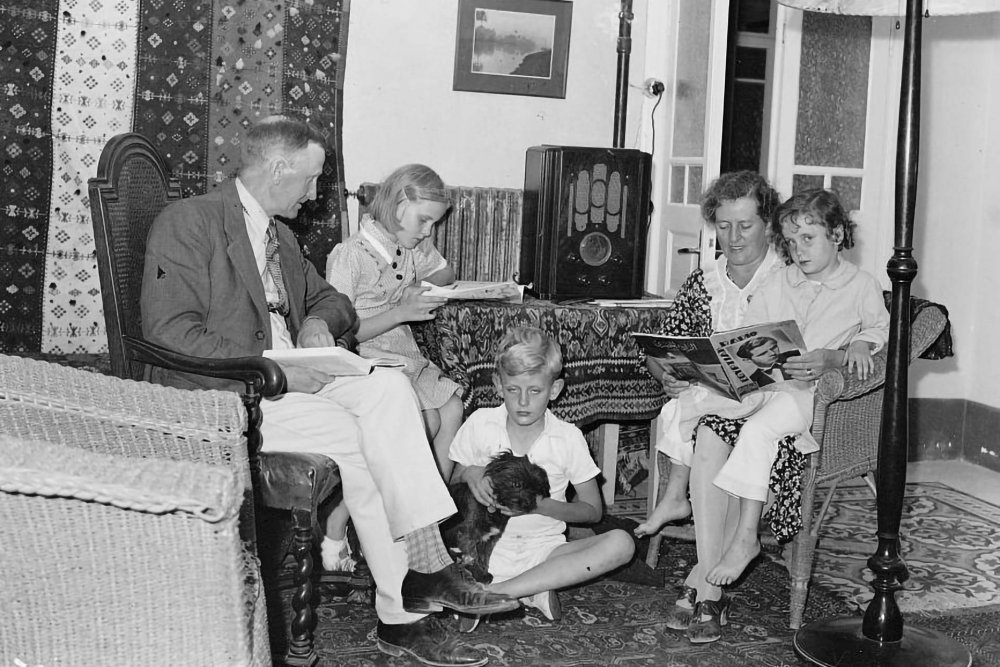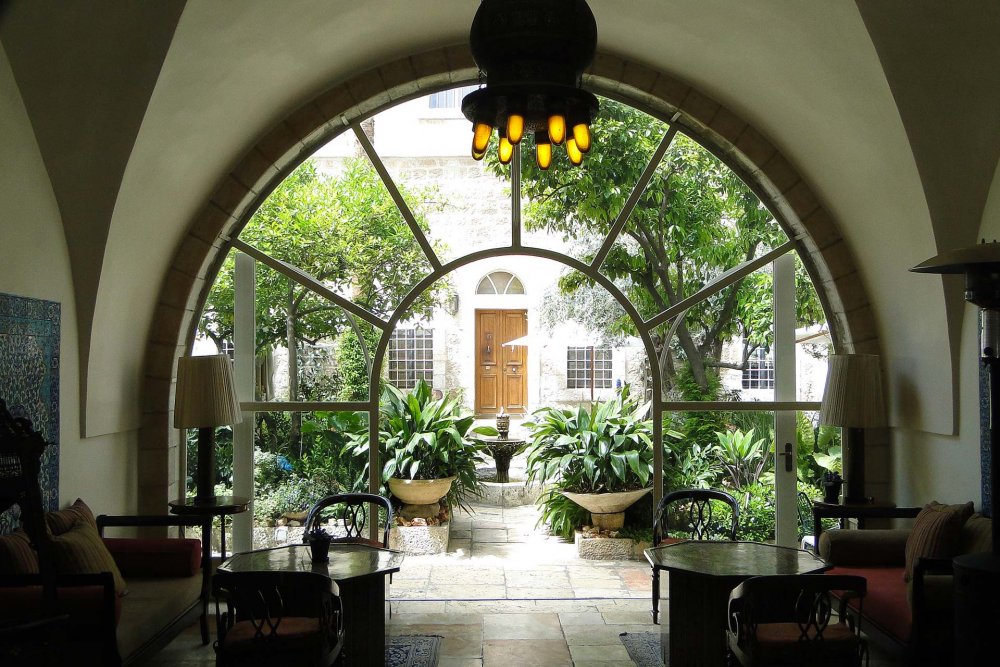In the mid-1860s, Rabah Daoud Amin Effendi al-Husseini was the first in his notable family, and one of the first in the city, to move outside the crowded Old City into the spacious orchards and groves surrounding it.1 He elected to build a palatial home for his four wives and daughters near the mosque in Sheikh Jarrah, off Nablus Road, a 10-minute walk from Damascus Gate. It had its own water supply and a foundation in the central courtyard. The expansive and gracious manse was described by Ilan Pappé in his history of the Husseini family as follows:
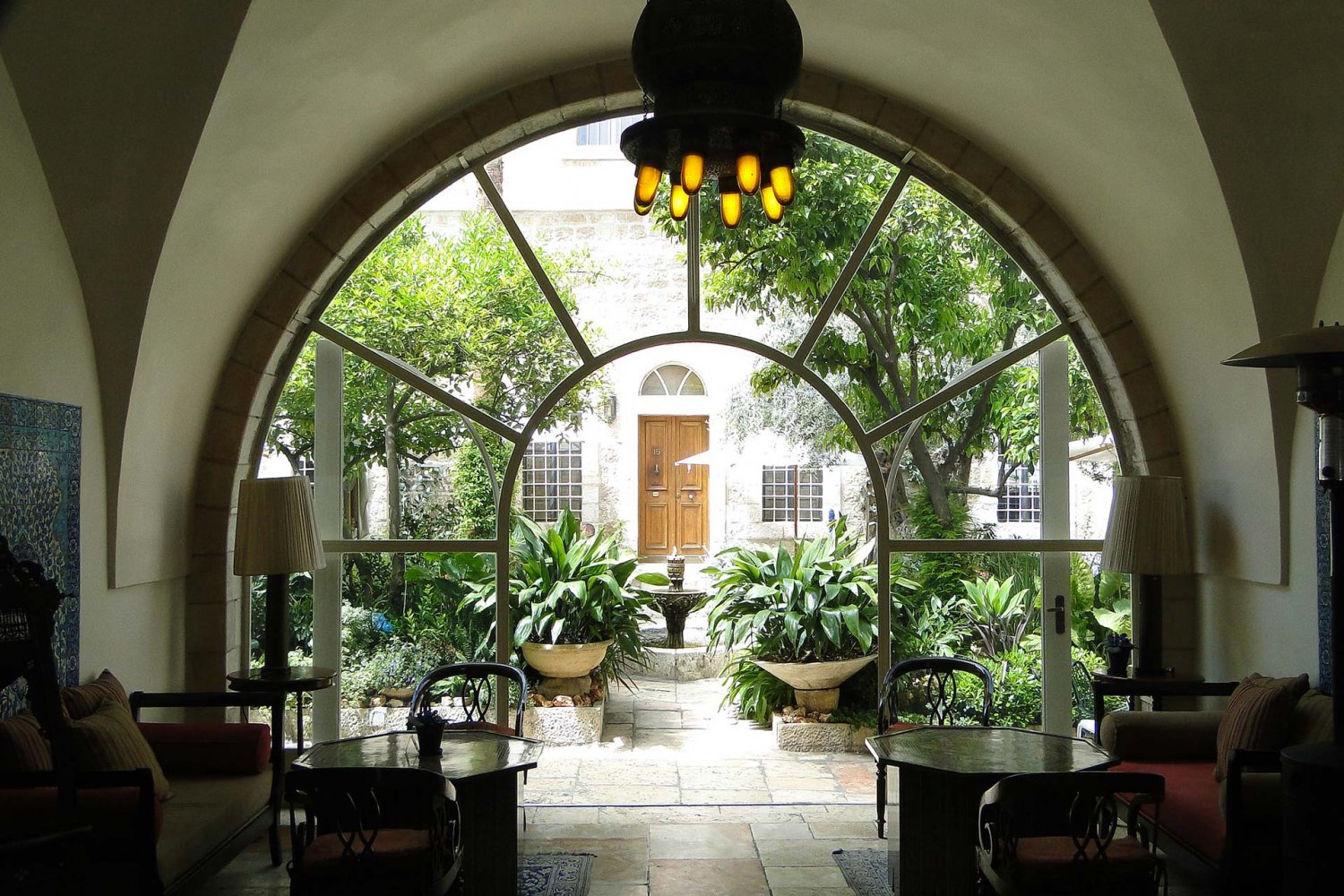
Credit:
Adam Jones, Creative Commons
The Unusual Origins of an Iconic East Jerusalem Hotel
In its time, Rabah’s palace had a novel style—spacious halls and rooms embellished with marble arches and carved wooden doors, built around a hexagonal patio full of climbing plants, variegated shrubs and fruit trees surrounding a hexagonal stone cistern. It was roofed with lightweight terracotta pipes to insulate it from extreme temperatures and faced with nari stone. The architect must have been partial to the six-sided form, which also dominates the main hall with its magnificent chandelier. A two-storey house with a basement, it covered two acres including the garden, and each of Rabah’s four wives had a separate wing. The first floor was the grandest, containing Rabah’s apartment and those of his wives, but it was the reception room, with the coffered wooden ceiling topped by a brightly painted dome, that most impressed visitors.2
Other family members soon followed suit, and by the early 20th century, the area became known as the Husseini neighborhood. Some other Palestinian notable families—including the Nusseibehs, Nashashibis, Jarallas, and al-Afifis—did the same,3 and Sheikh Jarrah thus gradually grew into an important economic and political hub of the city in the late 19th and early 20th century.4
Halfway across the world, in Chicago around the same time in 1861, Horatio Spafford, 33, married Anna Larsen (later Americanized to Lawson), 19.5 He was an attorney and a charismatic pastor; she was an attractive young immigrant from Norway whom he’d first met at age 15. She had lost her mother and then her father at a young age, and she lived with her married sister. She was not very interested in institutional religion, but she found him agreeable and thought he offered the chance for a better life. Their home was a hub for entertainment and socializing, including serious religious debates with fellow evangelicals. Within a decade, they had four daughters.
During those years, Horatio branched out from his legal career and started investing in real estate. For millennials during that period, religion and investing coexisted comfortably; “making as much money as possible was an absolute good.”6 Nothing prevented a good Christian from using the money beneficially. But his investments started to go badly, and soon he was borrowing heavily to cover his mortgages. The losses were compounded when he began to dip into funds entrusted to him by others, and compounded yet again when the Chicago Fire of 1871, which burned 15 city blocks, destroyed his plans to sell his property and plunged the city into an economic depression.
Anna was unaware of the extent of the financial disaster. She had been alone with the children when they had to be evacuated and was deeply affected by the city’s devastation.
Early Losses
Back in Chicago—possibly with the intention of shielding Anna from his downward spiral—Horatio insisted that she take their daughters to Europe. In November 1873, Anna and the girls set sail on the SS Ville du Havre. But on the seventh night, the ship collided with another vessel, the Loch Earn, and 232 people drowned, including the four Spafford daughters. It was the biggest marine disaster until the sinking of the RMS Titanic in 1912, when at least 1,500 were killed.
Anna was picked up unconscious and floating upon a plank of wood and then taken aboard the Loch Earn. She survived the tragedy, and her response to her children’s death struck those who knew her as odd. She selected a black-and-white mourning dress and asserted that her daughters were merely briefly separated from her. She claimed that while floating on the ship wreckage, she heard a voice telling her that she had been spared because she had work to do.
Horatio immediately went to Europe to escort her home and, by the time they returned to Chicago, they seemed oddly untroubled. She threw herself into social work and tried to assist women who had fallen into prostitution or domestic abuse in Chicago’s slums. Anna would go on to have three more children, but her only son would die at age four of scarlet fever in 1880.
A doctrinal schism in Horatio’s church led him to depart, together with a few others. They called themselves “the Saints”—others called them “the Overcomers.” He spelled out his religious beliefs in a pamphlet that some found scandalous, “the work of an infidel.”7 Among his controversial beliefs was the idea that Satan could be saved. His congregation believed in divine signs and actively looked for them.
The search for signs was not unique to this group of faithful but rather common among evangelicals at that time. On the strength of purported signs that the end-time was near, people found it perfectly sensible to sell everything they had and head to Jerusalem. As early as 1831, French philosopher and political scientist Alexis de Tocqueville summed up the situation he saw during a visit to the New World: “Religious insanity is very common in the United States.”8 European communities seemed to be afflicted with the same malady.
Following the death of her son, which occurred at about the same time as she learned the extent of her husband’s financial ruin, Anna began to consider leaving Chicago and its traumatic associations. The destination of Jerusalem seems to have been Anna’s idea. With Horatio’s arrest for financial misdeeds only a matter of time, and with evangelicals looking for signs (and wondering why the Spaffords seemed to be dreadfully punished by the Lord—wasn’t there a sign in that too?), the family hastily arranged to leave for Jerusalem in 1881, with a few congregants joining them to welcome the returning Christ. A group of 16 set sail for Jaffa, leaving without fanfare, presumably to avoid alerting the authorities to the pastor’s plans, which would put him beyond the reach of the law.
Arrival in Jerusalem
Soon after they arrived, they settled in a house in the Muslim Quarter of the Old City on the crest of Mount Bezetha, the highest point between Damascus Gate and Herod’s Gate. The house offered a spectacular view of the city and was high enough that the city stench didn’t reach them. It belonged to Ali Bey Juzdar, commander of the Turkish gendarmerie, and he agreed to rent it to them, together with two smaller adjacent structures.9 They remained in this house for many years, eventually buying it; when they moved out of the Old City some years later, this house was converted to the Anna Spafford Baby Nursing Home, named in honor of Anna.
A Chance Encounter
According to Bertha Spafford Vester, when they arrived in Jerusalem in September 1881 and had newly settled in their Old City home, they went for a picnic in Wadi Joz. Anna was bottle-feeding her youngest daughter, Grace, born January 18, 1881.
The picnic party attracted the attention of a local homeowner, who came down to their picnic site with a translator. While warm and friendly, he advised them that they were on his family’s land. Bertha recounts what happened next:
Above, on the hill, were some Mohammedan residences, and a young man, hearing our merry voices, came down to investigate. We had not known we were trespassing on his land. Through an interpreter he asked who we were and what we were doing. He was very friendly and Father invited him to share our picnic lunch. Mother was feeding Grace her bottle, and he was interested. “My mother has twin baby girls she cannot nurse,” he said, and added that she was trying, without much success, to feed them artificially. Mother went at once to his house and was given a friendly reception. She told the mother, through an interpreter, how ill baby Grace had been and how, through experience, she had learned what foods agreed with her. The twins were put on Nestle’s Condensed Milk, the only tinned milk we could buy in the market, and a friendship began that lasted to the present day and which was to start child welfare and nursing in the Holy City. The grapevine method of transmitting information soon spread the news.
The young man who joined our picnic was Mehedean Effendi Husseini and one of his baby sisters whose life Mother saved was Sitt Zakieh, who became the wife of Musa Kazmi [sic] Pasha, at one time the great nationalist leader of the Arabs who is buried in the Dome of the Rock compound—the Arab Westminster.
Immediately after the picnic in Wad ez Joz the Group was asked to give private lessons and instruction in schools.
Soon Mother’s letters home were filled with accounts of the work that needed to be done far more than the Group had the strength or ability for. She, Mrs. Gould, and Mrs. Whiting were nursing many sick people and teaching Arab and Jewish mothers how to care for their children, and Father and other men of the Group were teaching English and nursing.10
So this chance encounter immediately sparked the trust of the local community and started the ragtag group of Christians on a lifetime of community service.
The early years were difficult. The American Colony (the label by which they came to be known) had limited funds and, convinced that the Second Coming was imminent, members did not see a need to work, which meant that they soon exhausted their cash reserves. (For the same reason, their interest in nonreligious education was also limited.) They began to borrow to pay for what they needed. Initially, banks and individuals were willing to extend them a line of credit because they struck them as morally righteous and cultured people. Even when vendors stopped cooperating with them because they weren’t being repaid, there was always someone willing to send them food or other items.
Palestinians liked the pilgrims. They observed that these penniless newcomers never turned away anyone who showed up on their doorstep needing assistance, and did not hesitate to offer nursing care to the sick—even at risk to their own health. People also appreciated that, unlike the missionaries who flocked to the city intent on proselytizing, these Westerners showed no inclination to convert others but rather took a genuine interest in learning about their neighbors’ culture and religion. Some Palestinians began attending their services, not understanding a word but seemingly enjoying the fellowship and perhaps the singing.
One sign of particular interest to the Chicago pilgrims was the immigration of Jews to Jerusalem. They believed that an ingathering of Jews in the Holy Land was a prerequisite for the return of Christ, and they were heartened to learn that Jews were indeed immigrating to Palestine in large numbers. In 1882, they tried to assist a group of Yemeni Jews who were camping in town, shunned by other Jews. Horatio was convinced that they were a lost tribe of Israel and another sign that the end-time was near.
Household Arrangements
In Chicago, Horatio had been the group’s pastor. His wife was seen as an important presence, but more of a comforter than a spiritual force. That dynamic shifted in Jerusalem. Horatio took long walks to meditate and meet with townspeople, which left his wife more in charge of the household. Anna began to assert herself, calling herself the “Bride” and her husband the “Branch” (a reference to a verse in the Gospel of Saint John). She alone was the receiver of visions and divine manifestations. That gave her an authority that none of the others could question.
The spiritual hierarchy established in the household inevitably was reflected in its group dynamics. Gradually, Anna eclipsed her husband’s spiritual authority and the manifestations she claimed had the uncanny corollary of asserting her own authority over the members of her household. She renamed each of the colonists using biblical names she believed to be more fitting. (For herself, she insisted that she be called Sister Anna; later, she would be Mother Anna.) Weekly public confessions brought pressure to bear on members admitting to even trivial sins; members waited to hear Anna’s pronouncements and responded accordingly.
Family units were broken up because attachments were seen to interfere with spiritual obedience, and children were placed in the care of unmarried women. (This did not apply to Horatio and Anna’s own children, Bertha and Grace Spafford, or to Amelia Gould’s children. The Gould family would continue to get preferential treatment, most likely because the widowed Mrs. Gould had an inheritance.)
Six years or so after the move to Jerusalem, the Spaffords announced that celibacy was required to break man’s will: Married couples must refrain from sex, and wedding bands must be abandoned, presumably as a symbol of the renunciation of attachments. Later a “revelation” was announced that group members must pair with others but refrain from sex. (Not until 1904 or so was marriage sanctioned and parents allowed again to raise their children.)
Objections to Anna’s decrees were punished harshly. The Page family rejected the interference in what they considered a private matter, and the husband was banished from the house. His wife left with him, and they faced harsh conditions; she eventually died, her malnourished body not able to withstand the bitter cold winter. The husband was allowed to return to the fold, but he was a broken man. The example set by this punishment, combined with the fact that members had no funds and no real alternatives to turn to, ensured docility.
Eventually Horatio would be disciplined by his wife of 27 years in an equally harsh manner. He was condemned for “unfaithfulness” and shunned by the group for 44 days. In 1888, at aged 60, he died of malaria, emaciated and rambling, attended only by his daughter and another household member. After a brief period of isolation, during which Anna refused to see an old friend from her Chicago days, an evangelical who had come to offer his condolences, the matriarch resumed her place as the unchallenged head of the household.
A Colony under Attack
While the Americans had some local supporters, they had a fair share of detractors over the years; important among whom was the US consul Selah Merrill, who would continue to be a thorn in Anna’s side. Selah disapproved of the colony’s indolence and failure to repay debts, a disapproval that only grew stronger when he learned of the Spafford’s financial ruin in Chicago. Hearing about their insistence on celibacy added to his distrust. The two parties would spar over the years, especially when the consul was involved in removing bodies (including those of colony members) from the American cemetery on Mount Zion to make way for a Roman Catholic church.
Relatives of the colonists in the US grew alarmed when they received letters asking them to forward their inheritance funds to the colony. In one account, a professor who traveled to Jerusalem to see his sister, Mrs. Whiting, in the colony was prevented from having time alone with her. Mrs. Whiting and Mrs. Gould had inheritances they could claim, and when they traveled to the US in 1894 to press their case for access to their funds, they were accompanied at all times by Spafford’s trusted aides. The requests, made at Anna’s insistence, were only partially successful; Mrs. Whiting was unable to access her children’s inheritance, but Mrs. Gould was able to secure $2,000.11
But Anna seemed to have a gift for turning setbacks around to her advantage. While in the US in 1895, she was approached by Swedish Evangelical Church members who wanted to learn about the colony. She quickly took control of the congregation; in no time at all, she had sidelined the pastor. Many in the congregation decided to go with her to Jerusalem and forced the pastor to sell the church at fire-sale prices. A group of immigrants from a fraternal congregation in Sweden joined them in Jerusalem. The infusion of colonists from the US and Sweden brought with them cash and skills.
The Colony Enterprises
With the infusion of new blood, the needs of the colony changed. Now numbering about 130 people, it had outgrown its original home in the Old City and needed more space.
By this time, Rabah al-Husseini had died, destitute, his fortune somehow lost. Since he had no male heir, as per Islamic law, his home passed to male members of the extended family. In 1887, the group collectively decided to rent the house out. In the summer of 1896, this home was again available for rent and somehow Anna was able to make a deal and rent it for the enlarged group, now numbering some 130, of whom 40 were children.12
Bertha described the new house and the problems involved with taking it on:
Since Rabbah Effendi’s death his palace had been roughly used. It was large, and on this account difficult to lease, but it was exactly what we needed. We rented it at once. Nearly all the rooms were enormous and surrounded a beautiful open court. Rabbah Effendi had lived a patriarchal life there surrounded by his four wives and other relatives, retainers and servants.
From Hadj Raghib and his son therefore, we rented the present American Colony building in Sheik Jarah Quarter near the Kedron Valley, sometimes called the Valley of Jehoshaphat. Renting property in Palestine is not such an easy matter as it sounds. Innumerable heirs who have inherited bits and pieces all have to receive their share of the rent and sign the lease. Later, when we finally bought the property, we went through the same procedure. Every bit purchased increased the nuisance value of the unbought. The last two shares, from the Mufti of Jerusalem [Kamil al-Husseini] and his brother, whose mother had been Rabbah Effendi’s fourth wife before she married the Mufti’s father, were acquired at an exorbitant price.13
Her mother, Anna Spafford, relayed more details of the house and the use its new tenants were making of it in a letter dated October 5, 1902: We fill the new house [new to the American Colony] which contains twenty-two rooms. Besides this we occupy three houses which have respectively five and four rooms each. Then we occupy the lower part of a large house which contains five very large rooms and two small ones and three rooms for storing our stores. Some of the rooms in the smaller houses are used for Photography and silver plating and school rooms. Five rooms are thus used, leaving the rest for sleeping, parlour or salon as we call it here, and three dining rooms and one kitchen. Then we have added to one home two wooden rooms for cake baking and putting up jams, etc. which we sell. Then we have put up a good sized barn for our three horses and two donkeys and four cows and two calves, which we are raising. Then we have a carpentry shop, where all kinds of carpentry is done. Then we have a little blacksmith shop. So all together we work like a little village.14
The new immigrants included children, requiring a school; the old house was used for that purpose, and some Palestinians sent their children to it as well. (Families had to pay for supplies, but the school was free, which undoubtedly gained the colony some local goodwill.) The newcomers set up weaving looms and made cloth; some had tailoring skills and could make clothes for paying customers. As recalled by Bertha:
The looms and knitting machine were set up, and cloth woven for tablecloths. Weaving in all sorts of cotton and linen thread was tried, and the patterns were lovely. For many years we never bought table linen. It was all woven at the Colony. They wove material for furniture coverings that was beautiful. They even wove tweed for suits for our men out of native white-and-black lambs’ wool. The mayor of Jerusalem, Hassain Effendi el Husseini, wore a suit made from this material for many years. Its durability was everlasting.15
They set up a bakery, a carpentry shop, and a smithy and farmed the land. The colony had an antique shop near Jaffa Gate run by Frederick Vester and registered to his company; he was the husband of favored daughter Bertha.
In her memoirs, Bertha wrote, “Other industries were started, and little by little, with diligence, the Colony emerged from poverty.”16
A photography department was set up in 1897, taking the photos that would be in demand worldwide, especially during the turbulent years of the end of the Ottoman Empire and its replacement by the British Mandate.17 The images showed the landscape as well as the humanitarian projects of the American Swedish colonists, such as the sewing workshops in which local women were employed. Photographers were allowed behind Ottoman lines and could photograph battles with the British. Colony photographers were able to photograph the Ottoman Red Crescent. Photographs were sold in the Vester shop to pilgrims, tourists, and worldwide. Eventually, the department would amass an indispensable body of work that both documented the history of the American Colony itself and remains one of the scarce visual records of Jerusalem at the turn of the century and under the British Mandate.18
These ventures made money, all of which was turned over to Anna. Workers were not paid for their labor; should they need to buy even a pair of shoes, they had to ask a trusted Spafford aide for the money.
Also in 1897, perhaps as a result of the deepening connections between the Husseinis and the colony, Ismail Bey Husseini, son of Musa, newly appointed director of public instruction and a former student of Horatio’s, requested of Anna that the American Colony take charge of the only Muslim girls’ school in Jerusalem, which became the Islamic Girls’ School. The school was in an old madrasa abutting the Dome of the Rock. He wanted Bertha, then only 19, to head the school. To him, she was a natural choice: He had been her father’s pupil, and he had known Bertha most of her life.19 But Anna felt her daughter was too young and so insisted she colead with an elderly colony member who had previous life experience leading schools. After the first year coleading, Bertha took the helm herself and remained in that position until she married six years later.20
The Opening of the Hostel
With the larger space, the colony could also accommodate paying guests. At the turn of the century, it began operating as a hostel. Members soon found that their sleeping arrangements might be changed suddenly for guests; this too had the effect of psychologically rattling them, denying them any sense of control, not even over the beds they slept in. Children, too, could be pulled from their classes to wait on paying guests.
Anna was able to assert control by insinuating that some would be left behind on Judgment Day. Edith Larsson, daughter of the minister whose congregation had been snatched from under his nose and a member of the first group of US immigrants to join the colony at the end of the 19th century, later recalled with bitterness in her own memoir: “[The threat] created a fear of death in us, as a judgment for our sins, directly from God. I think it is impossible for anyone who has not lived under such religious fear to understand the impression this leaves in the consciousness of children.”21
By 1904, marriage was again sanctioned (it had to be, because Anna’s daughter, Bertha, was demanding to get married), and parents were allowed to raise their children. Some families had moved out and set up households of their own, in houses owned by the colony, and they found that they too could be moved around as required by management. (By this point, the ailing Anna was assisted by her daughter.) Questioning the arrangements could result in expulsion with nothing but the clothes on one’s back.
In 1910, the colony bought the Husseini house outright.22
The War Years and Beyond
During World War I, battles were raging for the control of Palestine. The colony was known for its neutrality. The Spaffords, who set the tone for the colony, eschewed nationalism and were open to other cultures. Because the American Colony was known to and trusted by Ottoman military commanders in Jerusalem, they asked colony photographers to document the war. Even after the US entered the war, the Ottomans asked the colony to run their six military hospitals and allowed them to continue their humanitarian work. Their acceptance most likely saved the colonists from being deported.23 It was an ironic twist of events for a community that for the most part eschewed medical intervention even for conditions that were readily treatable.
The colony ran a soup kitchen that fed thousands of desperate Jerusalemites each day. Donations were coming in from the US and elsewhere. In July 1917, at the height of World War I, the American Colony soup kitchen was closed by the Germans. Then the Palestinian community conceived of a way to transfer this management experience. As Bertha recalls:
It was about this time that the Grand Mufti of Jerusalem, Kamil Effendi al Husseini, who was half-brother of the present Mufti Hadj Amin al Husseini, came to Mother with the request that we would manage the Khaski Sultan soup kitchen called the “D’kieh.” It was an old and richly endowed institution, but the Turkish Government appropriated most of the revenue. The Mufti, a tall man of mild and gentle demeanor, had often stopped at our open-air soup-distributing center and watched us give out soup, before it was closed by a German mandate, on his way to his residence on the Mount of Olives road, northeast of the Colony. Busy as we were with running four hospitals, we could not refuse.24
When the British assumed control in 1917, the colony became a conduit for relief funds. They established and ran an orphanage (1918–22). Today the Spafford Children’s Center, set up in 1925 by Bertha, runs medical and outreach programs for Palestinian children and their families.
The End of the Colony, the Birth of the American Colony Hotel
Anna suffered from diabetes, and she died in 1923. Leadership of the colony was assumed by her daughter Bertha. A few months later, all of the colony’s valuable properties were registered in the names of her husband, Frederick Vester, and brother-in-law John Whiting.25 The daughter had as dominant a personality as her mother, but she had little interest in spiritual matters, and ran the colony’s various ventures as business enterprises that benefited primarily her own family. She sent her children to private schools in the US and wanted to live there herself, at least for part of the year.
After Anna’s death, frictions among colony members led to the community’s dispersal. Bertha expelled some members; others were encouraged to return to their native lands. Many left with little money. By 1930, the colony was in shambles, its coffers depleted by lawyer fees and family expenses.
When the dust from the court cases settled, Eric Matson was given control of the Photo Department and its assets, which were considerable. Eric retained the name until 1940 and then renamed the business The Matson Photo Service. Among the staff were Hanna Safieh and Joseph Giries, two Palestinian photographers who started as apprentices.
By the early 1950s, the department ceased operations. Recognizing the value of the archives he held, he approached the Library of Congress in the mid-1960s and turned over the collection to its care.26
The Vesters and Whitings, the descendants of Horatio and Anna Spafford, were awarded the large mansion. Today it is known as the American Colony Hotel, a luxury hotel in the Palestinian neighborhood of Sheikh Jarrah. The colony’s descendants own shares and meet twice a year for board meetings; the hotel is managed by a Swiss hotel company.
The boutique hotel with its elegant dining room became a city landmark and reference point, a storied meeting place for dignitaries and journalists alike, a place sought out by visiting actors and authors. For five years, the hotel housed the Office of the Quartet Representative. Palestinians have found the hotel to be a convenient place to hold press conferences and meet informally with journalists, where their presence is not challenged. Perhaps they value it, too, for the way it made the home of a distinctive Jerusalem family synonymous with world-class hospitality.
Notes
Mahdi Sabbagh, “The Husayni Neighborhood in Jerusalem: Space of Self-invention,” Jerusalem Quarterly 72 (2017): 106.
Ilan Pappé, The Rise and Fall of a Palestinian Dynasty: The Husaynis 1700–1948 (London: Saqi, 2010), 57.
Pappé, The Rise and Fall, 58.
Sabbagh, “The Husayni Neighborhood,” 106; Pappé, The Rise and Fall, 100–103.
Many of the details in this essay are drawn from Jane Fletcher Geniesse, American Priestess: The Extraordinary Story of Anna Spafford and the American Colony in Jerusalem (New York: Doubleday, 2008). The author, a New York Times reporter, spent seven years on this history of the American Colony. The 16-page bibliography includes 42 interviews, some of which were with people who lived in the colony and their descendants.
Geniesse, American Priestess, 30.
Geniesse, American Priestess, 84.
Geniesse, American Priestess, 4.
Geniesse, American Priestess, 101.
Bertha Spafford Vester, Our Jerusalem: An American Family in the Holy City, 1881–1949 (Jerusalem: American Colony, 1988), 107–8.
Geniesse, American Priestess, 131–32, 156–65, 195.
Vester, Our Jerusalem, 178, citing a letter or journal entry written by her mother at the time.
Avner Amiri and Annabel Wharton, “Home in Jerusalem: The American Colony and Palestinian Suburban Architecture,” Post-Medieval Archaeology 45, no. 2 (2011): 240.
Amiri and Wharton, “Home in Jerusalem,” 258.
Vester, Our Jerusalem, 177.
Vester, Our Jerusalem, 177.
The American Colony Hotel’s photo collections include anywhere from 7 to 10,000 photos and are stored in archives on the hotel premises; other collections were donated to the Library of Congress. Nada Awad, “Waiting for the Second Coming: The New Photographic Collection of the American Colony Archives,” Jerusalem Quarterly 60 (2015): 101.
Barbara Bair, “The American Colony Photography Department: Western Consumption and ‘Insider’ Photography,” Jerusalem Quarterly 44 (2010): 28–38.
Pappé, The Rise and Fall, 106.
Vester, Our Jerusalem, 180–81.
Pappé, The Rise and Fall, 106.
Vester, Our Jerusalem, 180–81.
Geniesse, American Priestess, 181.
Amiri and Wharton, “Home in Jerusalem,” 240.
World War I, Library of Congress.
Vester, Our Jerusalem, 246–47.
Geniesse, American Priestess, 297.

